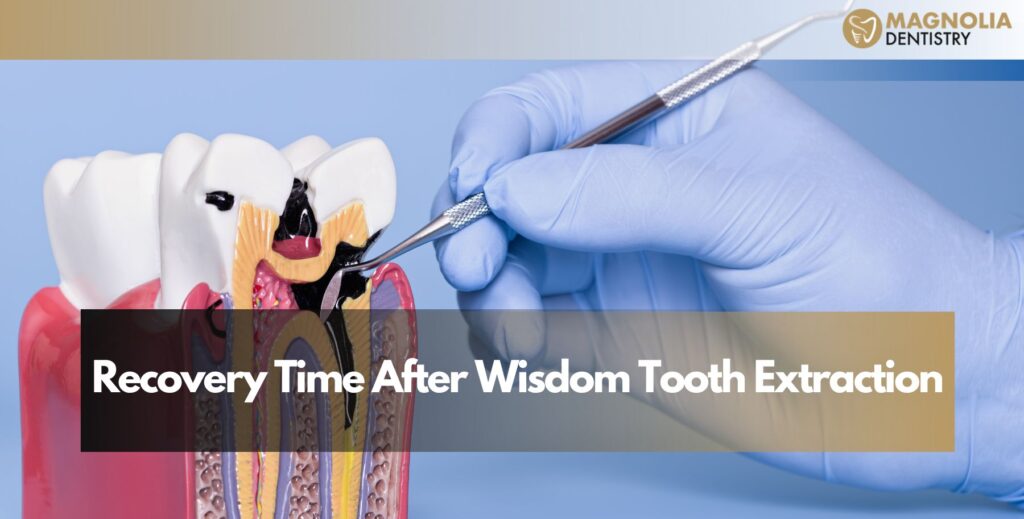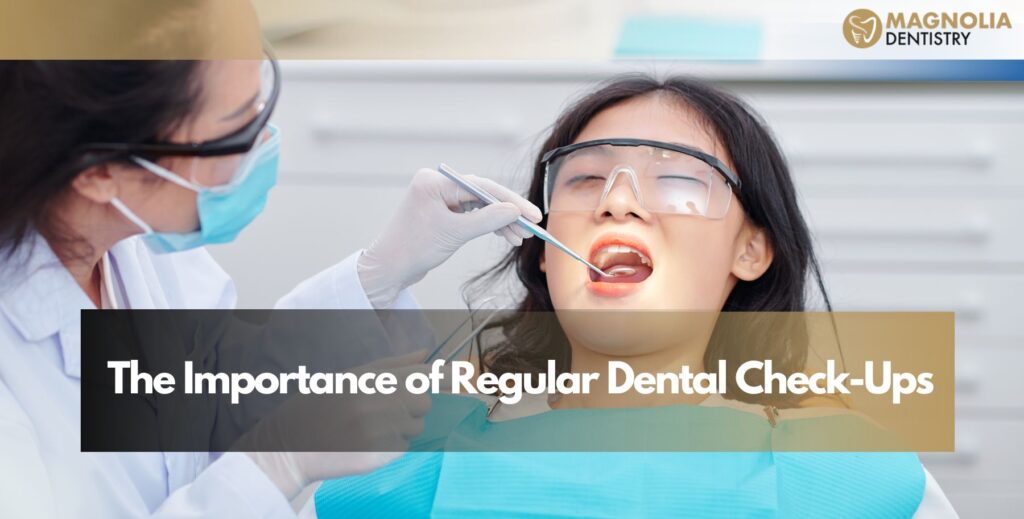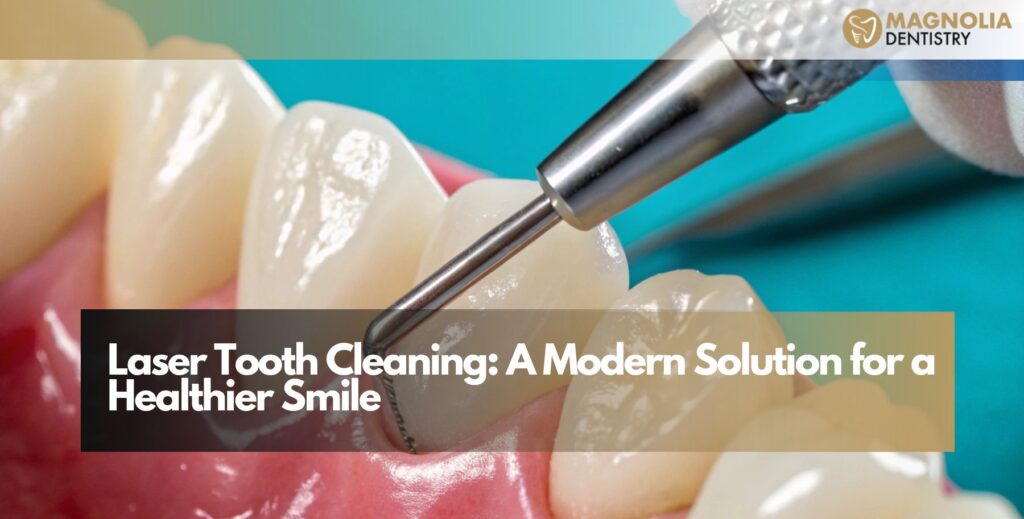Having your wisdom teeth removed is one of the most common oral surgeries performed today. While the procedure itself is routine and safe, what most patients are curious about is how long it takes to recover — and what to expect during that healing process. Understanding the wisdom teeth recovery timeline can help you prepare, heal faster, and avoid complications after the extraction.
At Magnolia Dentistry, we prioritize both comfort and proper healing for every patient undergoing wisdom tooth removal. This guide explains the typical wisdom teeth removal recovery timeline, what symptoms are normal, and how you can care for your mouth to ensure a smooth recovery.
Understanding the Wisdom Teeth Recovery Timeline
Every patient heals at a slightly different pace, but on average, full recovery after wisdom tooth extraction takes about 7 to 14 days. The exact duration depends on factors such as how many teeth were removed, whether they were impacted, your age, and how closely you follow your post-operative care instructions.
The recovery process occurs in stages, with the most noticeable healing happening in the first few days after surgery.
Day 1–2: Initial Healing and Blood Clot Formation
The first 48 hours after surgery are crucial for forming a protective blood clot over the extraction site. This clot shields the underlying bone and nerves, promoting healthy healing.
During this period, mild swelling, discomfort, and minor bleeding are normal. You’ll likely be advised to:
- Bite down on gauze to control bleeding.
- Use ice packs to reduce swelling.
- Take prescribed pain medication or over-the-counter pain relievers as directed.
- Avoid spitting, rinsing forcefully, or using straws to prevent dislodging the blood clot (which could lead to dry socket).
Soft foods like smoothies, yogurt, mashed potatoes, and soups are best during the first two days.
Day 3–4: Reduced Swelling and Discomfort
By the third or fourth day, you should notice swelling and soreness beginning to subside. This marks the transition from acute healing to recovery. Some stiffness in the jaw is still normal, especially if your wisdom teeth were impacted.
Continue using warm compresses instead of ice to ease muscle tension and improve circulation. Gentle saltwater rinses may be introduced (if approved by your dentist) to keep the extraction area clean.
You can start introducing soft, solid foods like scrambled eggs, pasta, or oatmeal as long as you chew carefully and avoid the extraction sites.
Day 5–7: Noticeable Improvement in Comfort and Function
By the end of the first week, most patients report significant improvement. The swelling should be minimal, and discomfort should be manageable or nearly gone.
At this stage, you can usually return to your normal routine — work, school, or light physical activity — provided you’re not experiencing pain or bleeding.
The extraction site may still feel tender, but the gum tissue continues to close around the wound. Keeping the mouth clean is key to preventing infection. Rinse gently with warm salt water after meals to remove food particles and bacteria.
Week 2: Healing Continues Internally
By the second week, your gums should appear mostly healed, and any bruising or stiffness should be gone. If sutures were placed, they are often removed or dissolve on their own during this period.
However, it’s important to remember that while the surface tissue heals quickly, the bone and deeper tissues continue to recover for several weeks. Avoid hard or crunchy foods like chips, nuts, or popcorn until your dentist confirms complete healing.
If you notice unusual pain, swelling, or an unpleasant taste, contact your dentist right away — these could be signs of infection or dry socket.
Factors That Affect the Wisdom Teeth Removal Recovery Timeline
No two recoveries are exactly the same. Several factors can influence how long it takes for your mouth to heal fully after wisdom tooth extraction.
Complexity of the Extraction
Impacted or surgically removed wisdom teeth require more healing time than simple extractions because the procedure involves more manipulation of gum and bone tissue.
Number of Teeth Removed
Having all four wisdom teeth removed in one visit typically extends recovery compared to removing one or two at a time.
Age and General Health
Younger patients tend to recover faster since their tissues regenerate more quickly. Overall health, hydration, and nutrition also play major roles in healing speed.
Post-Operative Care
Following your dentist’s aftercare instructions precisely — from managing pain to maintaining oral hygiene — can significantly shorten your wisdom teeth recovery timeline.
Smoking or Alcohol Consumption
Tobacco and alcohol can delay healing, increase infection risk, and cause complications like dry socket. It’s best to avoid them entirely during recovery.
Tips to Speed Up the Wisdom Teeth Recovery Timeline
Even though healing takes time, following these practical tips can help minimize discomfort and promote faster recovery:
Keep the Extraction Area Clean
After the first 24 hours, gently rinse your mouth with warm saltwater several times a day. This reduces bacteria and keeps food debris from accumulating.
Stick to a Soft Diet
For the first few days, avoid crunchy, sticky, or spicy foods that could irritate the extraction site. Stick to mashed potatoes, smoothies, soup, and yogurt.
Manage Swelling and Pain Properly
Apply ice packs during the first 24 hours and warm compresses afterward. Follow your dentist’s medication guidelines carefully.
Rest and Avoid Strenuous Activity
Avoid exercise or heavy lifting for the first few days to prevent bleeding and swelling. Rest allows your body to focus on healing.
Stay Hydrated (Without Straws)
Drink plenty of water to support healing but avoid using straws — the suction can dislodge your blood clot and cause complications.
Avoid Tobacco and Alcohol
Both can interfere with healing and increase your risk of infection or dry socket. Wait at least a week or as directed by your dentist before resuming these habits.
Attend Your Follow-Up Appointment
Regular check-ups allow your dentist to monitor healing progress and ensure there are no complications.
When to Call Your Dentist During Recovery
Mild swelling, bleeding, and discomfort are normal for the first few days, but certain symptoms require prompt attention. Contact your dentist if you experience:
- Severe or worsening pain after day three.
- Persistent bleeding beyond 24 hours.
- Fever or chills (possible infection).
- Difficulty swallowing or opening your mouth.
- Pus or a foul odor from the extraction site.
Prompt care helps prevent serious complications and ensures your wisdom teeth removal recovery timeline stays on track.
Long-Term Healing After Wisdom Tooth Extraction
Although most patients recover in about two weeks, complete internal healing can take several months as the jawbone fills in the extraction sockets. You may still feel slight tenderness when chewing hard foods, but this gradually disappears.
By maintaining good oral hygiene and following your dentist’s advice, you’ll help your gums and bone heal completely, minimizing the chance of infection or long-term issues.
Conclusion
The wisdom teeth recovery timeline varies slightly from person to person, but with proper care, most patients heal comfortably within two weeks. The first few days require the most attention, as this is when blood clot formation and initial healing take place.
At Magnolia Dentistry, our goal is to make your recovery smooth, quick, and stress-free. From expert surgical care to personalized aftercare instructions, we ensure every step of your healing process is managed with precision and compassion.
If you’re preparing for a wisdom tooth extraction or have concerns about your recovery, contact our dental team today. We’ll guide you through every stage — from surgery to complete healing — so you can get back to smiling comfortably again.




